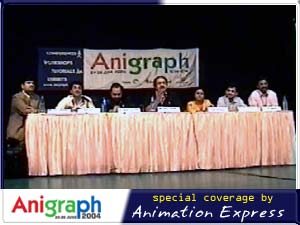Anigraph ’04 complete coverage: Day 2
MUMBAI: No doubt that India is yet to witness an actual trade fair like MIPCom, but it was heartening nevertheless, to see some of the key players of Indian animation sit together for the plenary session at Day two Anigraph 2004.
The plenary, ‘Localisation of Indian animation’ had the panelists rooting for Globalisation.

Amongst the panelists were Jadooworks COO Ashish Kulkarni, Animation Bridge CEO Biren Ghose, UTVtoons head Jyotirmoy Saha, Escotoonz CEO Aspi Mehta, 2nz CEO Kireet Khurana, Padmalaya’s Rajiv Sangari and Pentamedia’s Nirmala Nath. The topic discussed was ‘Localisation of Indian animation’. The panelists were of the opinion that globalisation not localisation was what would drive Indian animation ahead.
The plenary sessions were significant not because anything path breaking or new was discussed, but because of the fact that the industry figures came together under one roof to discuss issues. There is strength in numbers and the collective discussion augurs well for the industry.
The plenary sessions were significant not because anything path breaking or new was discussed, but because of the fact that the industry figures came together under one roof to discuss issues. There is strength in numbers and the collective discussion augurs well for the industry.
Earlier in the day there were some wonderful presentations. IS Mathur an academic consultant, formerly with the NID and currently consultant to Zica asked the audience to differentiate between need based education and value based education. He stressed on the importance of 2D classical animation saying that new technologies and machines will come and go but the basics and fundamentals of animation remain the same. He compared 3D artists who claim to be animators as bathroom singers saying, “A professional singer needs to have a strong classical base, he needs to know the seven notes of music, similarly a professional animator needs to have a strong classical base and needs to know of all the processes involved in 3D.”
Mathur was also very vocal about the pathetic drawing skills in the country. Lamenting that 40 per cent of the institute’s time and efforts spent in teaching and brushing up drawing skills of students which could have been better spent for teaching animation film making skills.
The smug Biren Ghose gave a talk on the business of Animation. Coining new words such as ‘ANIMONEY’ (money made out of animation) and ‘5D’ (projects made by combining 2D + 3D). Ghose stated that intangible assets such as Goodwill, processes, knowledge and experience were the X factor needed for studios to succeed. Citing the example of Bazee.com which was recently taken over by Ebay on the basis of the intangible value and potential that had been created around the brand. The exuberant Ghose urged the audience to aspire, saying “While you work and earn money,devote some time to developing ideas. Do not limit yourself,” he said.
Kulkarni delivered a tight and focussed speech on how infrastructure was needed to run a studio successfully. He stressed on the need for good infrastructure, the challenges one faced in setting it up and the benefits that accrue. Kulkarni had a cautionary note for studios that use pirated software saying that this led to unhealthy competition and under cutting. He also said that software makers in the US sometimes do approach clients asking them to shift outsourcing to other countries as piracy was rampant in India.
Kulkarni also stressed on the importance of owning licenses to a wide variety of software and the necessity of urging the workforce to be comfortable with all software. “This proves to be useful as each project demands a different treatment and requires technicians and animators alike, to be well versed with the various software.”
The two sessions on 2D and 3D animation delivered by Aargha Sengupta of Maya entertainment and Prince from Padmalaya were also very informative.
While Aargha demonstrated with illustrations the various elements of animation like anticipation, squash and stretch, Prince explained in detail on shapes and their psychological effects. He also discussed stereotypes and had many interesting illustrations (poetry too) to get his point across.
Indiantelevision.com’s Animation Express made an announcement inviting the students to share a sample of their best work. The illustrations (character or background) will be carried over a period of time in the forthcoming issues of the newsletter giving the students an opportunity to publicise their work.
As Day 2 neared to an end, one could see contented smiles on the organiser’s faces. They had promised a lot from the event and it seemed to be on course to deliver. Not solid solutions but at least a platform to seek them collectively.
It must be mentioned that CgA World held last month was a commendable effort too. The industry needs three to four more annual events like these to create what could be likened to an Indian animation grand slam.
Even as these workshops, tutor fests and conferences continue, One question still persists… When will India have its own animation trade fairs where actual business transactions take place?
